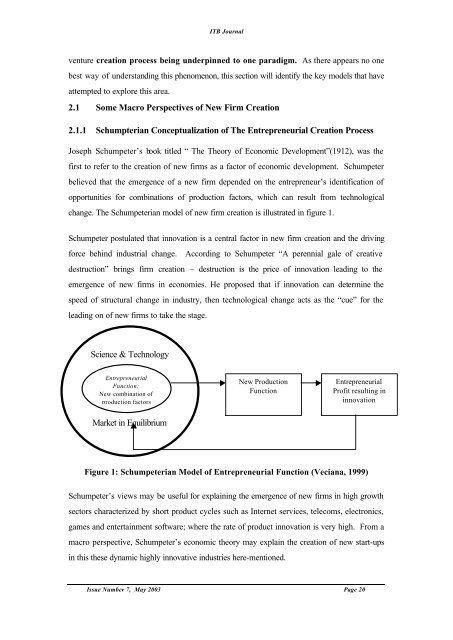ITB Journal-May-2003 - Institute of Technology Blanchardstown
ITB Journal-May-2003 - Institute of Technology Blanchardstown
ITB Journal-May-2003 - Institute of Technology Blanchardstown
You also want an ePaper? Increase the reach of your titles
YUMPU automatically turns print PDFs into web optimized ePapers that Google loves.
<strong>ITB</strong> <strong>Journal</strong><br />
venture creation process being underpinned to one paradigm. As there appears no one<br />
best way <strong>of</strong> understanding this phenomenon, this section will identify the key models that have<br />
attempted to explore this area.<br />
2.1 Some Macro Perspectives <strong>of</strong> New Firm Creation<br />
2.1.1 Schumpterian Conceptualization <strong>of</strong> The Entrepreneurial Creation Process<br />
Joseph Schumpeter’s book titled “ The Theory <strong>of</strong> Economic Development”(1912), was the<br />
first to refer to the creation <strong>of</strong> new firms as a factor <strong>of</strong> economic development. Schumpeter<br />
believed that the emergence <strong>of</strong> a new firm depended on the entrepreneur’s identification <strong>of</strong><br />
opportunities for combinations <strong>of</strong> production factors, which can result from technological<br />
change. The Schumpeterian model <strong>of</strong> new firm creation is illustrated in figure 1.<br />
Schumpeter postulated that innovation is a central factor in new firm creation and the driving<br />
force behind industrial change. According to Schumpeter “A perennial gale <strong>of</strong> creative<br />
destruction” brings firm creation – destruction is the price <strong>of</strong> innovation leading to the<br />
emergence <strong>of</strong> new firms in economies. He proposed that if innovation can determine the<br />
speed <strong>of</strong> structural change in industry, then technological change acts as the “cue” for the<br />
leading on <strong>of</strong> new firms to take the stage.<br />
Science & <strong>Technology</strong><br />
Entrepreneurial<br />
Function:<br />
New combination <strong>of</strong><br />
production factors<br />
New Production<br />
Function<br />
Entrepreneurial<br />
Pr<strong>of</strong>it resulting in<br />
innovation<br />
Market in Equilibrium<br />
Figure 1: Schumpeterian Model <strong>of</strong> Entrepreneurial Function (Veciana, 1999)<br />
Schumpeter’s views may be useful for explaining the emergence <strong>of</strong> new firms in high growth<br />
sectors characterized by short product cycles such as Internet services, telecoms, electronics,<br />
games and entertainment s<strong>of</strong>tware; where the rate <strong>of</strong> product innovation is very high. From a<br />
macro perspective, Schumpeter’s economic theory may explain the creation <strong>of</strong> new start-ups<br />
in this these dynamic highly innovative industries here-mentioned.<br />
Issue Number 7, <strong>May</strong> <strong>2003</strong> Page 20
















